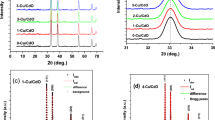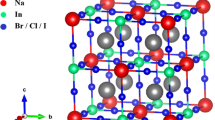Abstract
Lately, researchers have been investigating perovskite materials as they have attracted an enormous amount of attention due to their interesting properties. In this paper we are emphasizing the preparation method to obtain microcrystals or thick layers of CsPbBr3 perovskite materials. Prepared samples, on an ITO substrate, are characterized optically by the means of the stationary photoluminescence (PL) and the Time-Resolved photoluminescence (TRPL). Electrically, they are characterized by the meaning of I–V technique. The PL spectra of the microcrystal’s samples (denoted S1) show the presence of two peaks. The peak associated with the highest energy level allowed the determination of the bandgap energy (Eg), yielding a value of 2.37 eV. On the other hand, the thick layer samples (denoted S2) revealed a single sharp peak with a band gap energy Eg = 2.33 eV. The TRPL of S1 has shown a carriers’ lifetime τ = 37.2 ns. However, the S2 manifested a faster decay with a carriers’ lifetime τ = 0.88 ns. By studying the I–V responses, we have revealed that the Schottky contacts are sensitive to light, and they show a normal hysteresis (NH) and inverted one (IH) depending on the type of the sample. In both sample types, the manifestation of a self-heating phenomenon has been observed. Notably, this observation represents a novel contribution to the existing literature, as, to the best of the authors’ knowledge, such a phenomenon has not been previously reported in the study of CsPbBr3.










Similar content being viewed by others
Data availability
The authors confirm that the data supporting the findings of this study are available from the corresponding author, Hafedh BRAHIM, upon reasonable request.
References
J. Lim, M.T. Hörantner, N. Sakai et al., Elucidating the long-range charge carrier mobility in metal halide perovskite thin films. Energy Environ. Sci. 12, 169–176 (2019). https://doi.org/10.1039/c8ee03395a
E.J. Chukwuemeka, N.A. Osita, A.O. Odira et al., Performance and Stability evaluation of low-cost inorganic methyl ammonium lead iodide (CH3NH3PbI3) Perovskite Solar cells enhanced with natural dyes from Cashew and Mango leaves. Adv. J. Chem. Sect. A 7, 27–40 (2024). https://doi.org/10.48309/ajca.2024.406961.1384
M. Noman, M. Shahzaib, S.T. Jan et al., Optimizing band gap, electron affinity, & carrier mobility for improved performance of formamidinium lead tri-iodide perovskite solar cells. Mater. Sci. Eng. B 300, 117114 (2024). https://doi.org/10.1016/j.mseb.2023.117114
Q. Tai, K. Tang, F. Yan, Environ. Sci. (2019). https://doi.org/10.1039/c9ee01479a
M.M. Lee, J. Teuscher, T. Miyasaka et al., Efficient hybrid solar cells based on meso-superstructured organometal halide perovskites. Science 338, 643–647 (2012). https://doi.org/10.1126/science.1228604
A. Kojima, K. Teshima, Y. Shirai, T. Miyasaka, Organometal halide perovskites as visible-light sensitizers for photovoltaic cells. J. Am. Chem. Soc. 131, 6050–6051 (2009). https://doi.org/10.1021/ja809598r
F. Zhang, Y. Gao, D. Wang et al., Phase distribution management for high-efficiency and bright blue perovskite light-emitting diodes. Nano Energy. 120, 109144 (2024). https://doi.org/10.1016/J.NANOEN.2023.109144
G.H. Lee, K. Kim, Y. Kim et al., Recent advances in patterning strategies for full-color perovskite light-emitting diodes (Springer, Berlin, 2024)
H.L. Park, T.W. Lee, Organic and perovskite memristors for neuromorphic computing. Org. Electron. 98, 106301 (2021). https://doi.org/10.1016/j.orgel.2021.106301
K. Abiedh, B. Dhanabalan, S. Kutkan et al., Surface-dependent properties and tunable photodetection of CsPbBr3 microcrystals grown on functional substrates. Adv. Opt. Mater. (2022). https://doi.org/10.1002/adom.202101807
W. Lv, L. Li, M. Xu et al., Improving the stability of metal halide perovskite quantum dots by encapsulation. Adv. Mater. 31, 1–28 (2019). https://doi.org/10.1002/adma.201900682
H. Mai, X. Li, J. Lu et al., Synthesis of layered lead-free perovskite nanocrystals with precise size and shape control and their photocatalytic activity. J. Am. Chem. Soc. 145, 17337–17350 (2023). https://doi.org/10.1021/jacs.3c04890
A.A. Pradhan, M.C. Uible, S. Agarwal et al., Synthesis of BaZrS3 and BaHfS3 chalcogenide perovskite films using single-phase molecular precursors at moderate temperatures. Angew. Chem. Int. Ed. 62, 1–7 (2023). https://doi.org/10.1002/anie.202301049
X. Yang, T. Xu, Y. Zhu et al., Preparation of CsPbBr3@PS composite microspheres with high stability by electrospraying. J. Mater. Chem. C Mater. 6, 7971–7975 (2018). https://doi.org/10.1039/c8tc01408f
C.C. Stoumpos, C.D. Malliakas, J.A. Peters et al., Crystal growth of the perovskite semiconductor CsPbBr3: a new material for high-energy radiation detection. Cryst. Growth Des. 13, 2722–2727 (2013). https://doi.org/10.1021/cg400645t
G.A. Nemnes, C. Besleaga, V. Stancu et al., Normal and inverted hysteresis in perovskite solar cells. J. Phys. Chem. C 121, 11207–11214 (2017). https://doi.org/10.1021/acs.jpcc.7b04248
Y. Jiang, Y. Feng, X. Sun et al., Identifying inverted-hysteresis behavior of CH3NH3PbI3-xClx planar hybrid perovskite solar cells based on external bias precondition. J. Phys. D Appl. Phys. (2019). https://doi.org/10.1088/1361-6463/ab28d0
H.-S. Kim, N.-G. Park, Correction to parameters affecting I – V hysteresis of CH 3 NH 3 PbI 3 Perovskite Solar cells: effects of Perovskite Crystal size and Mesoporous TiO 2 Layer. J. Phys. Chem. Lett. 5, 3434–3434 (2014). https://doi.org/10.1021/jz502009r
J.M. Frost, K.T. Butler, A. Walsh, Molecular ferroelectric contributions to anomalous hysteresis in hybrid perovskite solar cells. APL Mater. (2014). https://doi.org/10.1063/1.4890246
W. Tress, N. Marinova, T. Moehl et al., Understanding the rate-dependent J-V hysteresis, slow time component, and aging in CH3NH3PbI3 perovskite solar cells: the role of a compensated electric field. Energy Environ. Sci. 8, 995–1004 (2015). https://doi.org/10.1039/c4ee03664f
V.W. Bergmann, S.A.L. Weber, F. Javier Ramos et al., Real-space observation of unbalanced charge distribution inside a perovskite-sensitized solar cell. Nat. Commun. (2014). https://doi.org/10.1038/ncomms6001
F. Gabelloni, F. Biccari, N. Falsini et al., Long-living nonlinear behavior in CsPbBr 3 carrier recombination dynamics. Nanophotonics. 8, 1447–1455 (2019). https://doi.org/10.1515/nanoph-2019-0013
M. Zhang, Z. Zheng, Q. Fu et al., Growth and characterization of all-inorganic lead halide perovskite semiconductor CsPbBr3 single crystals. CrystEngComm. 19, 6797–6803 (2017). https://doi.org/10.1039/c7ce01709j
M. Chen, Y. Yuan, Y. Liu et al., High-quality all-inorganic CsPbBr3 single crystals prepared by a facile one-step solution growth method. RSC Adv. 12, 14838–14843 (2022). https://doi.org/10.1039/d2ra01900k
P. Sujith, M. Pratheek, S.R. Parne, P. Predeep, Growth and characterization of high-quality orthorhombic phase CsPbBr3 perovskite single crystals for optoelectronic applications. J. Electron. Mater. 52, 718–729 (2023). https://doi.org/10.1007/s11664-022-10042-w
M. Zhang, Z. Zheng, Q. Fu et al., Synthesis and single crystal growth of perovskite semiconductor CsPbBr3. J. Cryst. Growth. 484, 37–42 (2018). https://doi.org/10.1016/j.jcrysgro.2017.12.020
H. Shi, X. Zhang, X. Sun et al., Direct and indirect recombination and thermal kinetics of excitons in colloidal all-inorganic lead halide perovskite nanocrystals. J. Phys. Chem. C 123, 19844–19850 (2019). https://doi.org/10.1021/acs.jpcc.9b04532
B. Zhang, F. Bin, Wang, H. Zhang et al., Defect proliferation in CsPbBr3 crystal induced by ion migration. Appl. Phys. Lett. (2020). https://doi.org/10.1063/1.5134108
W. Tress, J.P. Correa Baena, M. Saliba et al., Inverted current–voltage hysteresis in mixed perovskite solar cells: polarization, energy barriers, and defect recombination. Adv. Energy Mater. 6, 1–11 (2016). https://doi.org/10.1002/aenm.201600396
G. Tumen-Ulzii, T. Matsushima, D. Klotz et al., Hysteresis-less and stable perovskite solar cells with a self-assembled monolayer. Commun. Mater. 1, 1–7 (2020). https://doi.org/10.1038/s43246-020-0028-z
Funding
The authors declare that no funds, grants, or other support were received during the preparation of this manuscript.
Author information
Authors and Affiliations
Contributions
HB contributed to investigation, data curation, materials processing and characterization, and writing and original draft preparation. IC contributed to data Curation. FH contributed to methodology, supervision, project administration, and writing, reviewing, & editing. RM contributed to resources
Corresponding author
Ethics declarations
Competing interest
We declare that we have no financial and personal relationships with other people or organizations that can inappropriately influence our work. There is no professional or other personal interest of any nature or kind in any product, service, and/or company that could be construed as influencing in this manuscript.
Additional information
Publisher’s Note
Springer nature remains neutral with regard to jurisdictional claims in published maps and institutional affiliations.
Rights and permissions
Springer Nature or its licensor (e.g. a society or other partner) holds exclusive rights to this article under a publishing agreement with the author(s) or other rightsholder(s); author self-archiving of the accepted manuscript version of this article is solely governed by the terms of such publishing agreement and applicable law.
About this article
Cite this article
Brahim, H., Chiba, I., Hassen, F. et al. A comprehensive comparative investigation of thick layer and microcrystalline CsPbBr3 perovskite material: optical and electrical properties. J Mater Sci: Mater Electron 35, 753 (2024). https://doi.org/10.1007/s10854-024-12553-0
Received:
Accepted:
Published:
DOI: https://doi.org/10.1007/s10854-024-12553-0




